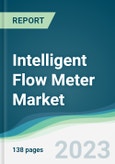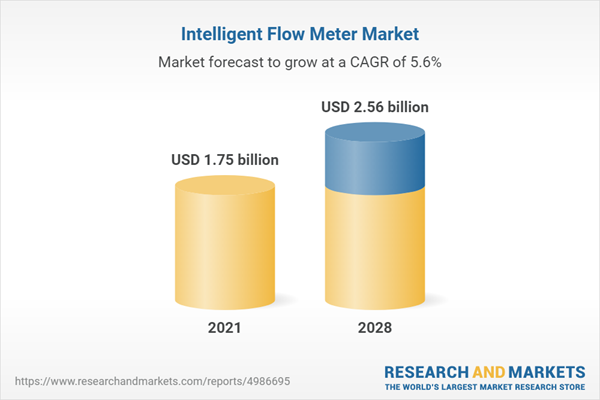The intelligent flow meters market was valued at US$1.748 billion in 2021 and is expected to grow at a CAGR of 5.62% over the forecast period to be worth US$2.562 billion by 2028.
The intelligent flow meter refers to devices that are designed to measure the rate of fluid flow in a system, such as a pipeline or a tank. Unlike traditional flow meters, intelligent flow meters are equipped with advanced sensing and communication capabilities that provide real-time data on fluid flow rates and other parameters, such as temperature and pressure. Intelligent flow meters are widely used in various industries, including oil and gas, water and wastewater, chemicals, pharmaceuticals, and food and beverage. They play a critical role in ensuring industrial processes' safe and efficient operation by enabling operators to monitor fluid flow rates and detect any abnormalities or deviations from expected values. Some of the key trends in the market include the development of wireless and non-invasive flow measurement technologies, the integration of AI and machine learning algorithms for predictive maintenance and performance optimization, and the increasing use of cloud-based platforms for remote monitoring and data analysis.In recent years, the intelligent flow meter market has experienced significant growth, driven by the increasing demand for accurate and reliable flow measurement solutions, the growing adoption of industrial automation and control systems, and the emergence of new technologies such as the Internet of Things (IoT) and artificial intelligence (AI).
The intelligent flow meters market is driven by growing water conservation and hydropower industry demand.
Intelligent flow meters provide accurate and reliable measurements of fluid flow rates and other parameters, which is essential for water conservation and hydropower generation. By accurately measuring flow rates, operators can ensure that water is used efficiently and effectively, reducing waste and conserving resources. The importance of safety and environmental sustainability is driving the adoption of intelligent flow meters in the water conservation and hydropower industries. By providing real-time data on flow rates and other parameters, these devices can help operators identify potential hazards and prevent accidents while enabling more efficient use of resources and reducing waste. According to the United Nations, water scarcity affects more than 40% of the global population, which is expected to rise due to climate change, population growth, and urbanization. This has led to an increasing focus on water conservation efforts worldwide, which in turn is driving the adoption of intelligent flow meters and other technologies that can support efficient and sustainable water management.Additionally, as hydropower generation continues to grow, there will be an increased demand for flow meters to measure water flow in various parts of the hydropower generation process. This could lead to increased demand for intelligent flow meters, which are designed to provide more accurate and reliable measurements. With the rise of hydropower generation, there may be a greater emphasis on using newer and more advanced technologies to optimize the generation process. This could lead to greater adoption of intelligent flow meters, which can provide more advanced data and insights than traditional flow meters.
Market Developments:
In December 2021,
ABB announced the launch of the AquaMaster4 Mobile Comms flowmeter. It is a wireless solution for continuous flow measurement and logging of accurate data critical for water management. With superior connectivity on 4G-LTE and NB-IoT networks, it enables 60% lower power consumption and identifies leaks ten times faster than the market standard.In August 2022,
the Indian government announced financial support of US$400K to M/s Kritsnam Technologies to develop smart water management technologies. As a result, the company created a product called the "Dhaara Smart Flowmeter," which is an all-in-one system that utilizes two-beam ultrasonic flowmeters to monitor water distribution in real-time for various applications such as drinking water supply, industrial water usage, groundwater extraction, and precision irrigation.Based on industry verticals, the intelligent flow meters market is expected to witness positive growth in the oil and gas segment.
The need for intelligent flow meters in the oil and gas sector is increasing due to the requirement for precise and consistent flow rate measurement and better efficiency. Furthermore, strict environmental emission restrictions and the need for cost-effective solutions contribute to the growth of the intelligent flow meter market in the oil and gas industry. Further, according to the report by Pietro Fiorentini, the oil and gas sector continues to evolve with new research and development initiatives being undertaken worldwide. For example, the ongoing installation of an oil well in the Persian Gulf will likely have a substantial influence on the sector. This project entails extracting oil and gas resources in the region using innovative drilling techniques and equipment.North America accounted for a major share of the global intelligent flow meters market, especially in the United States.
The intelligent flow meters market has been segmented by geography into North America, South America, Europe, the Middle East and Africa, and the Asia Pacific.The rise in infrastructure development projects and expenditure by developed countries in North America, such as the US and Canada, is a significant factor driving the growth of the North American intelligent flow meters market. In addition, the region is further witnessing a high installation of intelligent flow markets due to the need for precise fluid calibration across many industries, including wastewater treatment and chemical sectors. Simultaneously the advancements in computer and other IT technologies are driving the adoption of intelligent flow meters in North America.
The need for precise liquid or fluid flow tracking in water treatment facilities, power plants, and refineries is increasing the demand for intelligent fluid flow meters across different industrial sectors, including petroleum, chemical, and wastewater management factories in the country. In addition, intelligent flow meters can provide data in real-time to make informed decisions concerning the recalibration of a process or initiation of a specific maintenance procedure, increasing its demand in the US market.
Key Market Segments
BY VALVE TYPE
- Linear valve
- Globe valves
- Pinch valves
- Others
- Rotary Valves
- Ball valves
- Plug valves
- Butterfly valves
BY TECHNOLOGY
- Intelligent Ultrasonic Flowmeters
- Intelligent Vortex Flowmeters
- Intelligent Electromagnetic Flowmeters
- Others
BY INDUSTRY VERTICAL
- Chemicals
- Oil and Gas
- Pharmaceuticals
- Water and Wastewater
- Paper and Pulp
- Others
BY GEOGRAPHY
- North America
- USA
- Canada
- Mexico
- South America
- Brazil
- Argentina
- Others
- Europe
- Germany
- France
- United Kingdom
- Italy
- Others
- Middle East and Africa
- Saudi Arabia
- UAE
- Israel
- Others
- Asia Pacific
- China
- India
- Japan
- South Korea
- Taiwan
- Thailand
- Indonesia
- Others
Table of Contents
1. INTRODUCTION
2. RESEARCH METHODOLOGY
3. EXECUTIVE SUMMARY
4. MARKET DYNAMICS
5. INTELLIGENT FLOW METERS MARKET ANALYSIS, BY VALVE TYPE
6. INTELLIGENT FLOW METERS MARKET ANALYSIS, BY TECHNOLOGY
7. INTELLIGENT FLOW METERS MARKET ANALYSIS, BY INDUSTRY VERTICAL
8. INTELLIGENT FLOW METERS MARKET ANALYSIS, BY GEOGRAPHY
9. COMPETITIVE ENVIRONMENT AND ANALYSIS
10. COMPANY PROFILES
Companies Mentioned
- Emerson Electric Co.
- Endress+Hauser Group Services AG
- CIMTEC Automation LLC (General Electric)
- KROHNE Messtechnik GmbH
- Yokogawa Electric Corporation
- ABB
- Azbil Corporation
- Brooks Instrument
- Sierra Instruments, Inc.
- Siemens AG
Methodology

LOADING...
Table Information
| Report Attribute | Details |
|---|---|
| No. of Pages | 138 |
| Published | May 2023 |
| Forecast Period | 2021 - 2028 |
| Estimated Market Value ( USD | $ 1.75 billion |
| Forecasted Market Value ( USD | $ 2.56 billion |
| Compound Annual Growth Rate | 5.6% |
| Regions Covered | Global |
| No. of Companies Mentioned | 10 |









